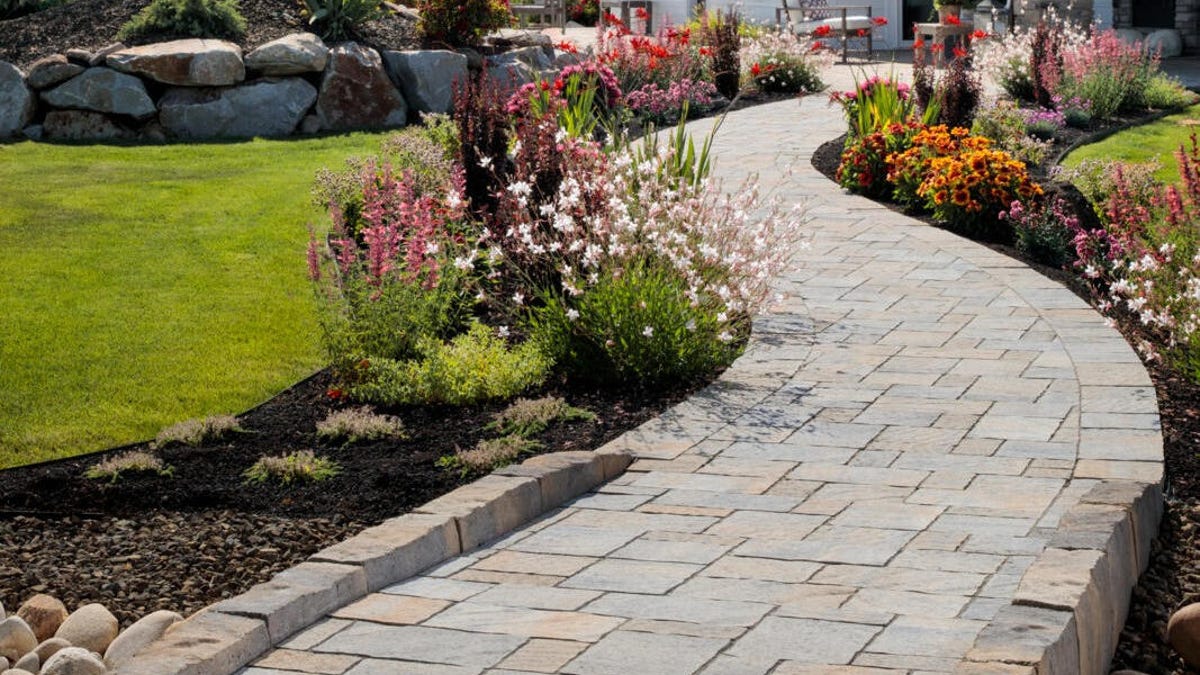 Why You Can Trust CNET
Why You Can Trust CNET Paving stones: DIY a paver patio in 6 easy steps
Paving stones are a great way to spruce up your home's outdoor areas. Here's how to use them.
Paving stones are a powerful tool you can use to create unique and beautiful areas in your home's outdoor spaces. Available in a wide variety of shapes, sizes and materials, they're a relatively simple way to add extra style to your front or back yard.
For instance, paving stones are great for sprucing up patios, walkways and firepit areas. They offer a good range of design aesthetics, too. Are you partial to natural stones? Perhaps you prefer uniform patio stones? Maybe traditional cobblestones or shaped concrete blocks are more your speed. Whatever direction you go, there are pavers available for creating pathways, patios, borders and even driveways.
If you're considering a paving-stone project like that, then you've come to the right place. This guide lays out what you need to know to use pavers well. We'll also provide guidance about how to select the right ones and we'll give pointers on how to install your paving stones properly, too. Do it right and your designs will last for years to come.
Some types of paving stones can be used to create striking driveways.
Paving stone materials
The first phase of your project is to decide the look and feel of the stone you'd like to use. Paving stones come in three main material types: natural stone, concrete and brick. Keep in mind that the thickness of the stone and its material composition contribute to its overall strength. This variation means that some types of paving stones are better suited than others for certain purposes.
For instance, most pavers are strong enough for basic use, say in a garden or for a patio with regular foot traffic. However, pavers that are used to build a driveway must be able to withstand the weight of vehicles -- you'll need to make sure to select stones that are specifically designed and graded accordingly. Most home improvement stores such as Lowe's and Home Depot specifically list whether a type of paving stone they sell is up to this task.
No matter how simple or elaborate your paving-stone project is, having a plan always helps.
Step 1: Make your project map
Creating a clear depiction of the scale of your plan is a must. Start by marking the edges of your project with string, a paint line or another outlining method. Next measure the length and width of these edges. Multiplying these measurements will give you the total area you'll need to cover. From that you can determine the number of paving stones your project calls for, depending on their size.
Step 2: Create a solid base
You might get away with dropping patio stones down into an existing landscape without digging up any soil. Your best bet, though, is to excavate the target area first, then fill it with a base material. Commonly used items include crushed concrete, crushed shell or limestone. These substances will ensure that the stones sit level.
You don't need to dig too deep. Digging and removing a few inches of earth is often all that's required. The goal is to unearth roots or other items that would have otherwise made your pavers settle unevenly over time.
If you do plan on a deeper excavation, it's a good idea to check with your local utilities first. The last thing you want is to hit a buried gas or electrical line by accident.
Once excavation is complete, you can start laying down a thin layer of your base material.
Step 3: Even out your surface
To avoid any stones sitting or settling higher than others, you'll need to even out your base layer. A tamper tool comes in handy for small areas. Larger projects such as driveways may require you to use a plate compactor.
Also, consider that in some cases you might want to add a gentle slope to your patio to provide drainage away from your home and avoid the pooling of rain water.
Step 4: Put down your pavers
After you've covered your project area with base material, it's time to deploy your paving stones. Drop them as close together as possible. Keep in mind that you may need to trim a few stones if they don't fit exactly to your plan.
If you just need to trim a few oddly fitting stones, you can use a hammer and chisel. Any more than that and you'll have to rely on a specialized saw or other power tool.
Step 5: Consider restraining edges
For patios and larger installations, a concrete restraining edge, aka an edge restraint, might be necessary. It acts as a barrier and prevents the pavers from moving as the earth settles over time. There are also special pavers that serve as edging stones. As an alternative, you can buy hard plastic edging pieces that can hold your patio stones in place. Those will also help to keep out weeds and grass.
Step 6: Seal to preserve
As a final step, think about adding a sealer to your paving stones. Doing so will create a weather barrier and help preserve the finish of your patio, walkway or driveway. A sealer can also help to guard against color loss from exposure to the sun.
Acrylic- and water-based sealers are available in a variety of gloss levels. Be sure to follow the directions on your sealer packaging carefully to ensure that it adheres properly.


